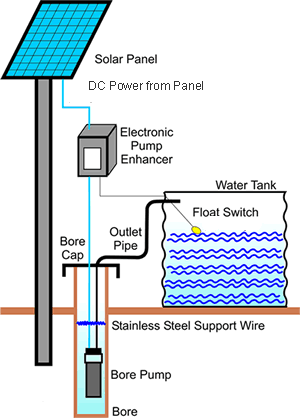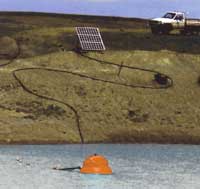 What are Solar Water Pumps ?
What are Solar Water Pumps ?
Solar pumping systems work anywhere the sun shines. Pumping water is a sensible and effective use of solar electric power. During the hot months, when water requirements are highest, a solar pump will provide a reliable water source for a farm. Wind power, by comparison, can be inconsistent, and may not be available during the hottest months in many inland areas. Wind may be too unreliable for water pumping when a relatively constant supply is required, particularly for when watering animals.
A solar water pumping system is essentially an electrically driven pumping system. Electricity, in this instance, is produced by the sunlight energising photovoltaic (solar) modules. The typical solar cell is a thin wafer of silicon that transforms light energy into electrical energy. The cells are encapsulated in flat modules to protect them from the weather. Any number of modules can be connected together to form an array. The array is sized to meet a pumping systems’ power requirements.
A solar pumping system is available for almost all applications where an electric pump can be used. Because solar energy varies from one location to another, and over the course of a day, system design is important. Adequate water storage ensures that water is available whenever needed, and balances daily variations in water supply and demand. Thus a small pump only running when the sun shines, plus water storage, can often provide all that is requiremed for water supply.
Different needs can be serviced and systems are determined by the quantity of water to be pumped:
1. Water for drinking & cooking
2. Water for livestock
3. Water for crop irrigation
There are also a number of other minor uses such as the small pumps used in solar fountains . For the best electrical and mechanical performance, all components of the solar pumping system must be carefully matched. Correct sizing of the pump, motor and controlling devices, will allow the system to operate at the highest efficiency to ensure economical water pumping.
 Surface Water Pumping
Surface Water Pumping
Pumps like the Mono Sun-Ray have been designed to transfer surface water with both efficiency and reliability in mind. These types of pumps are available with either a stationary or GPS Tracking solar array and range in size from 150W to 1575W. The Sun-Ray mentioned can deliver very high daily flows up to discharge pressures of 120m.
Some solar water pumps have floating pontoons that are designed so the pump floats on a dam or other water source. This particular pump uses a highly efficient, helical rotor which is inherently self-priming. As such the pump can be positioned up to 6m above the water source, allowing the pump to be installed on the top of dam walls or on river-banks above the high water mark.
Surface solar water pumps are suitable for pumping from springs, rivers, tanks, and dams. Incorporating a float and/or pressure switch input enables complete system automation and can be set up only to pump as long as water is needed and will stop once tanks or troughs are full.
Solar Water Pumps – Bores
Solar water pumps are also designed to lift water from bore-holes, and the pumps range in size from small units for low water volumes or low yield bores, right through to systems that pump in excess of 60,000 litres per day.
There are solar pumps on the market that can lift from over 240 metres (780 feet) below the ground surface and also have speed control to adjust and reduce flow rates if needed. They have no submerged electronic parts and are protected against overload, reverse polarity and dry running.
Solar pumping systems operate quietly, create little pollution and only use sunlight as fuel. In terms of sunlight required to operate, many solar water pumping systems are based on 6 PSH (Peak Sun Hours). PSH refers to the number of hours per day that the sun shines at the rate of 1000 watts per square metre (solar insolation). Solar insolation is a measure of the amount of sunlight available to the solar panels in order to power the pump. Of course the insolation factor is affected by cloud, haze, smog and varies seasonally.
